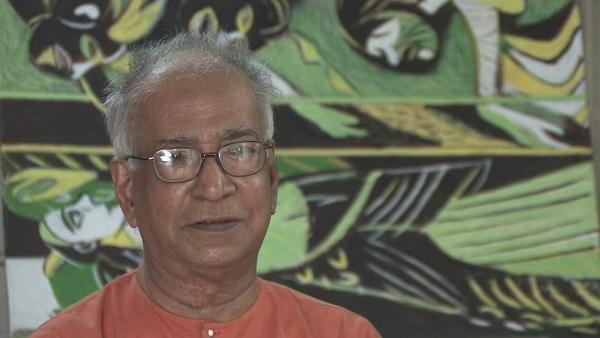NEXT STORY

Developing relationships with Benode Bihari Mukherjee and Ramkinkar Baij
RELATED STORIES

NEXT STORY

Developing relationships with Benode Bihari Mukherjee and Ramkinkar Baij
RELATED STORIES


|
Views | Duration | |
|---|---|---|---|
| 11. Travelling to Santiniketan and being searched by the police | 62 | 02:20 | |
| 12. Life at Santiniketan and Nandalal Bose | 122 | 03:36 | |
| 13. Santiniketan and Gandhism | 59 | 05:12 | |
| 14. Mohandas Gandhi and art (Part 1) | 67 | 06:54 | |
| 15. Mohandas Gandhi and art (Part 2) | 60 | 06:52 | |
| 16. Gandhi and Nandalal Bose | 75 | 07:30 | |
| 17. Tagore | 64 | 04:47 | |
| 18. Art and religion | 64 | 06:58 | |
| 19. Benode Behari Mukherjee, Brahma and Tulsidas’ monkey god | 84 | 04:47 | |
| 20. Developing relationships with Benode Bihari Mukherjee and... | 60 | 03:14 |


Is this a good moment to ask about Benode Behari’s Life of the Hindi Saints?
Huh?
The Life of the Hindi Saints? It is a sort of religious picture.
In fact, since I worked with him, I have some kind of an idea of what he... his idea of religion was very much affected by the idea of Brahma religion because the whole question, they thought in terms of its human centre.
Will you explain Brahmo please?
The Brahmo religion really, or of course they say there is only one God, they don’t encourage idol worship. In the beginning, the Brahmo religion came very close to Unitarian Christianity. Then later, of course, it took on various openness and kind of creatures. So it is a kind of a liberal religion which lays off the various distortions that have come into Hindu thought, and in normal orthodox Hindu thought. Otherwise, the late Brahmo religion with the Tagore family, it was like that. I mean they did believe in a god, but as far as we know Benode Behari was concerned, he was more nearer to what the Brahmo religion, a little tempered by the folk religion of Bengal, auls and bauls and all, where they say they can think of God as a man who remains in the mind, moner manus they say. And each man, if he finds out that centre, he almost undergoes a kind of reincarnation of a kind, and his whole, he was, if it was... I do not know if it was originally conceived that way, but he did mark out various ways that the Indian public was trying to sort of search out for this kind of reality. So, he starts with the first focus on the religion of the hills where the rishis meditated, then discussed the various questions of right and wrong.
This is the mural itself?
Yes, the mural. Then it goes into the various teachers who became great pillars of various sects, then into the religion of the common man, the worker, the... and then some of them became great figures just by the simplicity of their vision. Then the literary Jains who had their kind of religion, then finally the militant religions of the Sikhs and the others, and the folk religion. I mean, that is the kind of period. Now I have read about it somewhere, but then it is that his idea of religion was, I mean, if you have to reconstruct what happened, you will have to see it in the life around. So when you think in terms of the various figures you are putting there, historical references only with one or two, maybe he got the phase of Ramananda from Vaishnava Ramayat, which they worshipped. All the other signs he had modelled on the basis of Ramakrishna Paramahamsa whom they saw in pictures or saw in person. Then, when it comes to the craftsmen saints, he sort of drew from the figures of craftsmen saints. In fact, there is no real portrait of Kabir, but a supporter there can always be, so he tried to do that.
And Tulsida?
Ah ha, Tulsidas, in Tulsidas case, he has written it from a sort of Brahmin view, but then his guru, according to the legend, his guru was Hanuman, that is the monkey god, but he has not made him a sort of monkey god. He has not even given the guru any hair, but he thinks that he is a kind of person who probably had a name of Hanuman, but who is sort of a great thinker.
KG Subramanyan (1924-2016) was an Indian artist. A graduate of the renowned art college of Kala Bhavana in Santiniketan, Subramanyan was both a theoretician and an art historian whose writings formed the basis for the study of contemporary Indian art. His own work, which broke down the barrier between artist and artisan, was executed in a wide range of media and drew upon myth and tradition for its inspiration.
Title: Benode Behari Mukherjee, Brahma and Tulsidas’ monkey god
Listeners: Timothy Hyman
Timothy Hyman is a graduate of Slade School of Fine Art, London, in which he has also taught. In 1980 and 1982, he was Visiting Professor in Baroda, India. Timothy Hyman has curated many significant art exhibitions and has published articles and monographs on both European and Indian artists.
Duration: 4 minutes, 48 seconds
Date story recorded: 2008
Date story went live: 10 September 2010